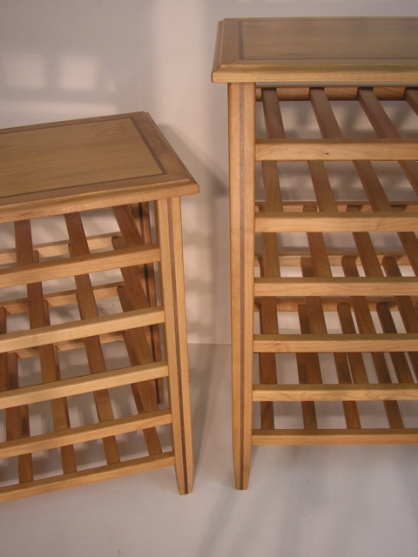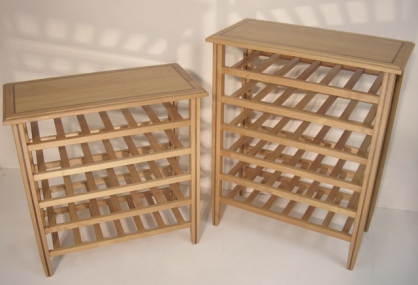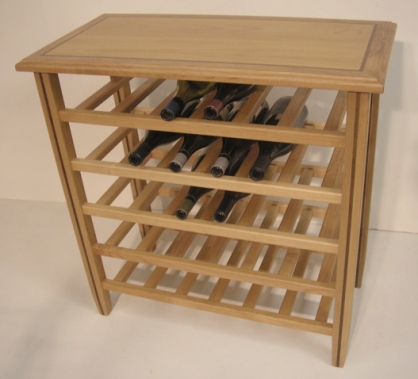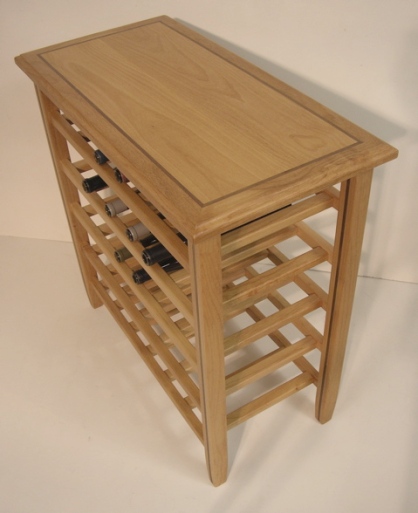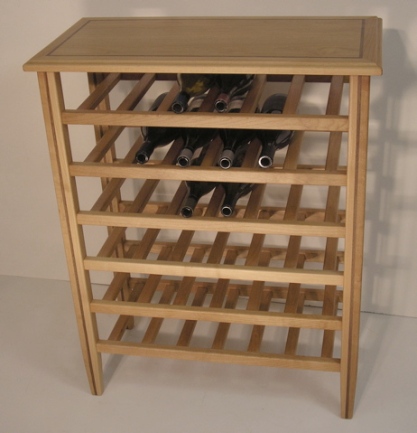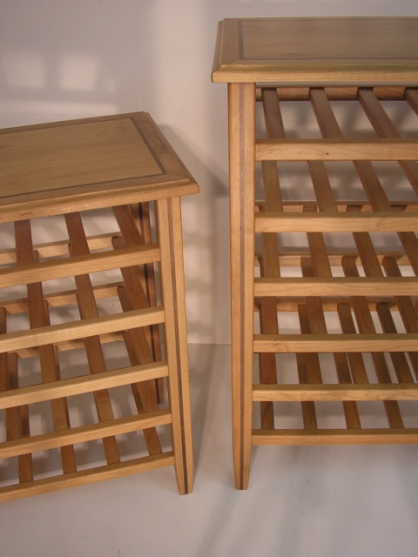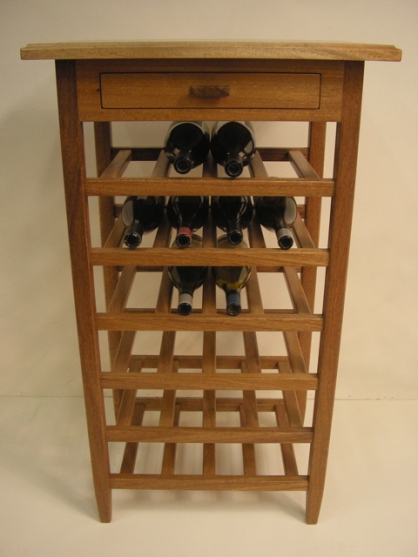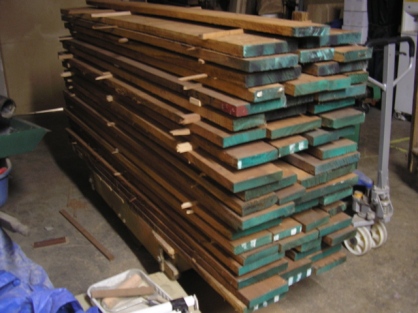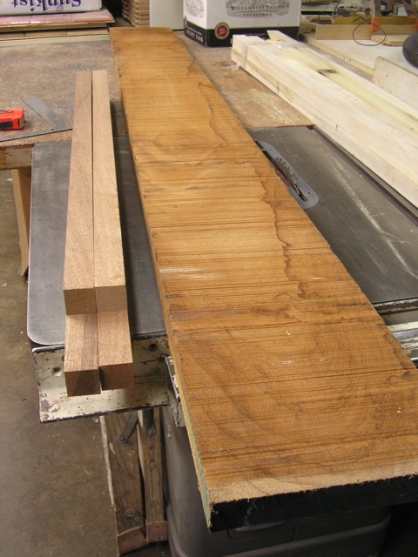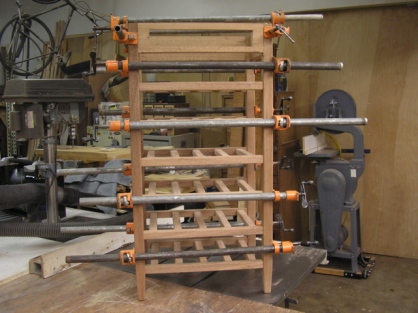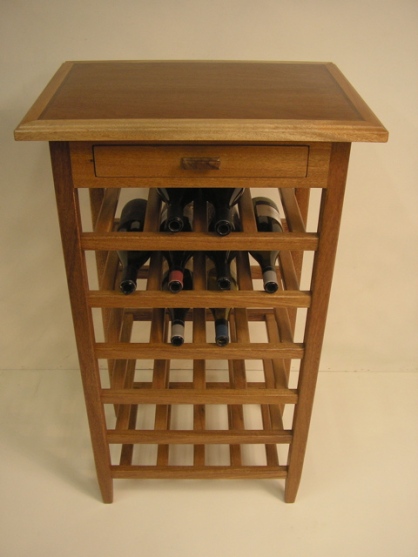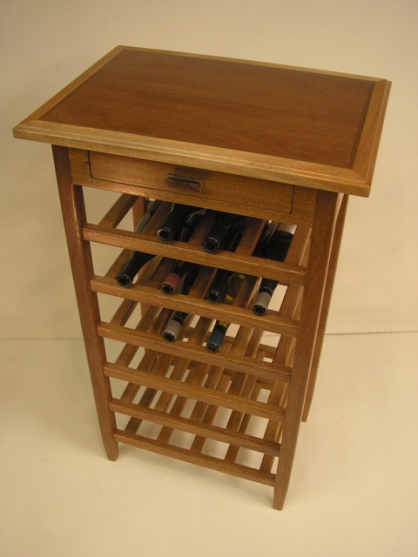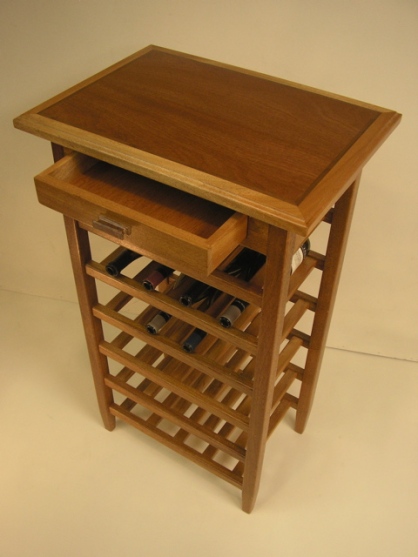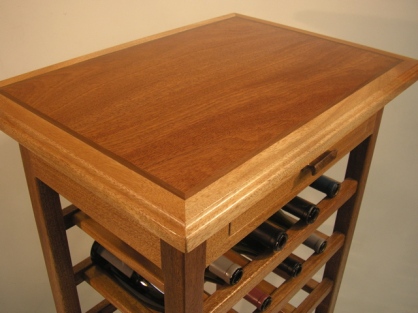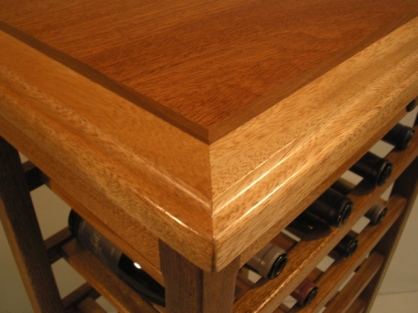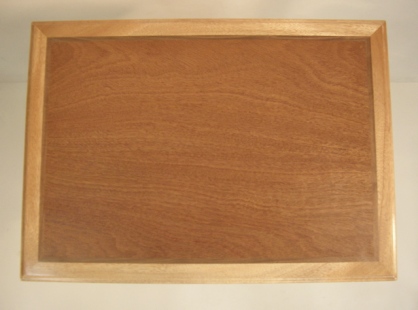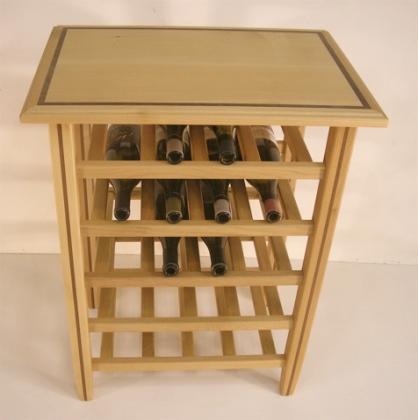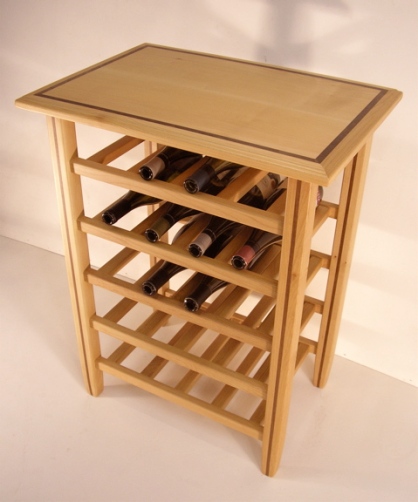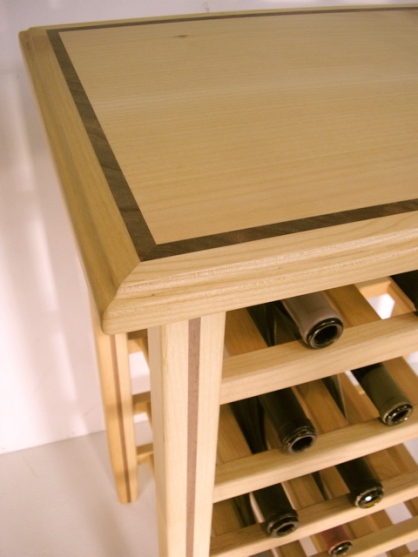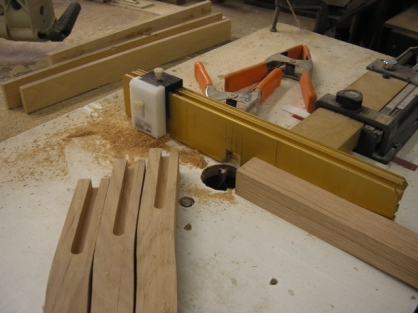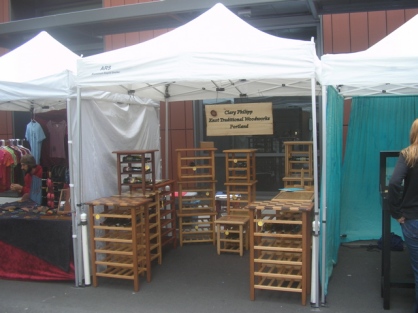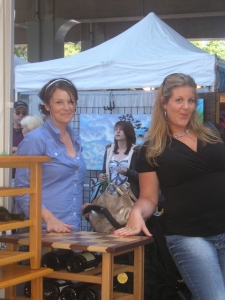Wine Racks Hand Made In Portland Oregon, USA
August 1, 2011
Are you serious about your stash of wine? GOT RACKS??
A pair of six bottle wide racks that I cut out at the same time. Don’t they look naked without any wine bottles? That is where you aficionados come in…
… fill these racks with wine! Wouldn’t they look better with an eclectic mix of glass colors and labels? Ha,ha, ha!
It would be too easy for me to draw a bunch of different rack designs, then go to my lumber supplier, buy a bunch of material and make them up. The first problem with that is that the material would cost me money. This is not a tool that I have.
If you have followed this blog at all you know that I’m a scrappy, dumpster diving, recycling, reclaiming, up-cycling, woodworking kind of guy. Most of this material was salvaged from my neighbors who build custom uhpolstered furniture. They can’t really use small rips and off cuts from their manufacturing process, so they had been burning them or just putting it into the dumpster.
They buy ASC certified cabinet grade Alder. I really like the different shades of golden brown and tan that the water proof polyurethane finish I use imparts. For the features strip laminations, I use scraps of Oregon Black Walnut from logs I have dried and used for bigger pieces. I can’t bare to toss anything out, and I spend way too much of my time looking through stacks of scraps, to try and visualize what I might be able to make out of them.
I would have made an identicle pair but there weren’t any pieces long enough, so they are as tall as the pieces I could glean for the legs. It is so much harder to design and build pieces from found material.
I try to use the contrasting Black Walnut laminations to be part of the graphic image and design. The real reason is that I don’t get any really thick pieces and the woodworker in me thinks it is better to draw attention to the joinery than try to hide it.
If I had lots of big boards, so that I could make parts with all the color and grain patterns being similar, I could successfully deguise the joints. Still, I sort through stacks of my scraps to find complimentary color and grain patterns. But it’s organic you know? The boards were cut from trees growing out in the mountains. If you want it perfect, make it out of steel or plastic.
Free and Knot Free Wine Racks…
March 26, 2011
Lavrens, my neighbor at the shop, came through for me again. He has a buddy who works or worked for a Canadian lumber wholesaler. A few years ago when the economy was still functioning, they bought units of exotic lumber to sell to high-end users. As the economy was destroyed, they went back to selling construction grade lumber and plywood. That didn’t work either so they closed the warehouse.
When they cleaned out the building, this unit of lumber was not in the inventory, so Lavren’s friend gave it to him, and he gave some to me. It is an African Mahogany called Khaya Ivorensis or commonly Khaya.
I cut one of the pallet skids in quarters for some legs. I was impressed by beauty of the grain and the color. It is fairly hard and dense. I don’t like the way the sawdust smells. It is a little acrid, but not horrible like Ipe, and certainly not as nice as real Honduras Mahogany.
These must have been some big trees because it appears like all heart wood. It mills up straight and true with no warping or cupping. Nice to work with and easy to machine.
Since I had quite a lot of material to choose from, I decided to make a piece that is narrow and a little taller. It holds 24 bottles and has a drawer for cork screws, stoppers and wine glass charms. 23 1/2″ wide x 16 3/4″ deep X 40″ tall.
The top turned out great. I planed a piece, crosscut it, then joined it back on itself for the field. You can barely see the joint.
I used Oregon Black Walnut for the feature strip and drawer pull.
The edge band was from a different piece of lumber. It’s pretty amazing how different the colors turned out from piece to piece. After I sanded everything off, the colors seem rather uniform. The urethane I use made the grain and true colors pop out.
While the grain and figure from piece to piece is very uniform, look how different the legs are compared to the carcase, and the edge band against the field on the top.
Like I said, free from any knots… and my favorite type of wood too… free. Thanks Lavrens!
Knot another wine rack!
February 16, 2011
Yeah, another one. My neighbors who make custom upholstered furniture gave me a bunch of Alder scraps a few months ago. Every month or so, they get a unit of FSC Alder lumber and proceed to make piles of narrow rips and other scraps, perfect for me to mill into rack parts.
I generally try to make parts production style so I can efficiently produce two to four or five racks at a time. This one was cut out along with the rack on my last posting. My deal is to try making all my stuff out of solid wood and not glued up… if I can. It irritates me to look at production furniture and cabinets that boast solid wood, only to see glue joints everywhere.
As I have said before, it would be easy to draw ideas up, go to the lumber yard, buy a bunch of nice material and make cool stuff. The problem is that it costs money. If I could find ways to sell these things and recover that cost, I would be cranking out wild stuff from the many pages I’ve sketched in my design note books.
Sometimes I can find big enough pieces to make solid legs, but in this case, the scraps were wide and long enough, but not thick enough. To solve that, I laminate a different kind of wood so it becomes a part of the design, not just a way to use thinner (cheaper) material, like the typical manufacturing process. In the end, it’s no doubt cheaper, easier, to buy thicker 8/4 material for the legs, but like I said, it cost money. I have way more time than money. I began laminating parts so that they becomes part of the design and look on purpose. In this case, Oregon Black Walnut milled from some logs I dried.
The field for the tops are usually two pieces glued up, either book matched or a single board folded back on itself at the cut, so that the grain matches and many times make the joint invisible. I started using a contrasting feature strip when I laminate the tops for the same reason… make big parts out of small pieces and have the laminations be part of the design.
Knot normally the way I do it…
February 10, 2011
A lady saw photos of a wine rack I posted for sale on craigslist and contacted me. I invited her to the shop to see what different pieces I have in my inventory. She had a corner in her dining room where she wanted to place it and we discussed dimensions.
She looked at completed racks and I explained how the modular nature effected the over all dimensions. She gravitated to a piece that was constructed from Black Walnut and Sapele, and said she really liked the redish color of the Sapele… also know as African Mahogany. She ask what color of stain I used.
I had to laugh and said that there was no stain, I use different hardwoods to show off their natural color. There is no reason to use a stain. I do however use stains on the pieces I make out of soft wood like Pine, Fir or Cedar. I showed her a couple of those different pieces and some raw wood to illustrate how washed out the natural wood looks generally. She wanted, if not to match, at least compliment her dining room table.
She ask how much the Walnut/Sapele piece was and I said it was three times as expensive as the Fir/Pine ones. It was too small for her but she really liked it. I had to laugh again. I said, you have good taste, your like my wife. She sees a red car and says, wow that is a beautiful car, I want one of those. I say, baby you have good taste… that is a Ferarri. How about that red car over there? No, I don’t like that so much. Well Babe, that’s a Toyota.
I had three racks made from Alder that were recently glued up but I had not made tops for yet. They were the right dimension and bottle capacity for her. I showed her the two most common tops I make… Mitered edge band, with or without a contrasting feature strip, and the Breadboard style with through tenon joint.
She liked the Breadboard style, saying that the way I leave the tenon protruding matched her table’s styling. I told her that I never stain hardwoods, but that furniture manufacturers routinely apply stains to Alder. I pulled out my drawer full of sample stain cans and proceeded to wipe stain on some Alder scraps. The first one or two colors were spot on for her. So I made a Breadboard top, stained the piece and applied three coats of polyurethane.
She picked it up yesterday and said it looked great. As much as I would love to be purist, use highly figured exotic woods and tradition oil and wax finishes… I’m not a snob. In the real world, it’s only other woodworkers that really know the difference between a Ferrari and a Toyota… or care. While it’s Knot normally how I do things, it pays the bills. I did like the way it turned out and more importantly so did she. Thanks for the support… another one goes to a good home.
Knot a Wine Rack…
January 16, 2011
It has been about a year since I started this blog. 2010 was one of the worst years I have lived through. Almost nothing went right, I never caught a break and almost every single thing I tried to do, blew up in my face. I feel like a complete failure.
Having said that, I’m not alone. It was hard for almost everybody I talk with. I got a message from WordPress telling me enough people viewed my blog to fill two 747 air planes. Lot of good it did. I got very few comments and even less interest in my wine racks. It’s very disapointing and some what frustrating.
I’m going to try an keep the shop going, but I don’t see how. I don’t have any emotional attachment to it really. Carpentry and wood working is what I have been doing for a living for a long time and I don’t really know what else to do. I going to try and keep going until I can’t anymore. I enjoy the work but it’s not who I am or what I’m about as a person, just a way to try and make money.
This is a piece I built last month for a lady. It is to be used as a night stand. The shelves are for shoes and slippers. She gave me some rough idea of dimensions that would fit in the room and how high it should be for a reading lamp.
I looked through my piles of hardwood lumber and dried logs, but there wasn’t enough to make all the parts I needed in the sizes I wanted. Here is a shot of some Clear Verticle Grain Fir that I re sawed. It came out of a nasty looking old 6 x 12 beam, salvaged from a construction site. While it had some defects and a big knot, it is beautiful material.
It must have been a giant old growth tree by the close growth rings and how many there are. I’m always in awe when I think that every grain was a year… we must be looking at decades… generations to grow this tree.
Here is what’s left of a 2 x 12 somebody gave me fifteen years ago. It has some curly grain to it that is very delicate and most gorgeous. I used it for the legs and the laminated edge-band on the top.
I love the look and color of fir. It is very difficult to work with because it can be splintery and it’s not hard enough to resist dings and dents in furniture. I went with it anyway because it was free. Here are a bunch of parts and you can see that I cut the drawer fronts out of the face frame and glued it back together so that the grain would run through.
Here I am with the tenon cutting machine I built, making round tenons to join the legs with the shelves. I call it the pencil sharpener, because it’s like sharpening big pencils.
When working with fir, you need to have very sharp blades, bits and planer knives or else you get heart breaking tear out or splinters. Sometimes you may run a bunch of pieces through the router table very carefully and think you have it licked… then WHAM, a blow out that rips the piece apart so that the material is wasted.
There are tricks to dealing with this like “Climb Cutting” where you run the work backwards agains the bit so it doesn’t grab the splintery grain…. or making multiple passes, taking a small amount at a time… or both. But, still you never know when the fir will bite you.
I was lucky this time, because I used every trick I know to machine all these parts right the first time. I barely had enough material to design this piece and no spare boards for mistakes and mishaps. In the end, there was barely enough scrap to kindle a fire!
I didn’t make the same mistake that I did on the last piece I built where I flipped the face frame in my haste to glue up the carcase. It’s subtle, but for those who know to look, they are rewarded with the grain running through the frame and drawer fronts.
I mortised my signature drawer pulls that matched the grain too. The last two from a batch of pulls I ran years ago. It takes six router set-ups to make them, so I do it in big batches of all kinds of woods so i don’t have to stop in the middle of a piece and make some.
The thing that took me the longest and was the most difficult, was to design the shelves. The boards I had were just too narrow to use. So I had to come up with a way to make them wider. I drew a dozen solutions but the one I liked the most couldn’t be built. I mean I could draw it, but there was no way to glue and assemble it… looked nice though.
The feature strip in the top is from my dwindling stash of old growth California Redwood. You can’t see in the photos, but there are small “Bird’s Eyes” in the Redwood.
There were two defects in the board I used for the field in the top. I could cut one out, but not both. So, the squiggle you see is a huge splintery check that ran through the whole beam. I glued it and clamped it. When it was planed off it came out smooth. Hey, it was made by hand! This ain’t IKEA.
I sprayed three coats of poly-urethane varnish on it, sanding between the first split-coat and second full wet coat. Then I rubbed out the top coat with double ought steel wool. It gets rid of any sheen and makes it velvety smooth to the touch. It’s virtually water and alcohol proof and pretty stain resistant too. Sometimes candle wax will stain it, but it is the toughest finish I know how to apply.
Over time, it will get used, dented, scratched and dinged. Like I’ve said before, some day after I’m long gone, somebody will pick this piece up, see my signature on the bottom and know that it took took time out of my life to make.
What Next?
Knot How It’s Supposed To Work…
November 22, 2010
It can start with a need. In this case, a friend has been remodeling his house and needed to put a key in a door at the end of a hall. All he told me was that he wanted a table to put a lamp on, so he could see the door knob, and that the space in the corner of the hall was 10″ by not more than 18″.
I like to have some kind of symmetry in my designs and the one dimension that seemed fixed was the 10″. Quickly I thought, how about 10″ deep by 15″ wide and 30″ tall… multiples of five.
I looked through my piles of wood and lumber for some walnut but didn’t really find anything that jumped out at me. I uncovered some gnarly pieces of Red Oak that my friend had given me last year and I’d completely forgotten about. I planed off the sides to see some nicely figured pieces.
They were just 29″ long, perfect legs for a 30″ table height. I squared them up on the jointer and thickness planed them. There were a few defects, checks, splits and splintery grain. I also thought because the piece was pretty small, I needed to cut them down so they would make sense within the scale of the piece. Hopefully I could cut out the defects too.
I fooled around with a bent piece of quarter round moulding that I use with a string to adjust the bow for marking curves. My idea was to make curved legs and cut out the defects. I cut a piece of plywood the size of the leg blanks for a template.
The hardest thing to do was figure out the sequence of cuts so I’d have a flat surface to run the against the fence and get a square part with which to join the carcase. Here is the first cut…
…then flip it 90 degrees for the second cut, and still have a flat surface to run against the table.
Legs.
That was the end of the day. I had a few random pieces of Red Oak in my stash but not enough to do much. I left the shop that night about eleven thirty in a driving rain. I got to the end of block where there is a new and used resteraunt supply business. They always have stacks of pallets and cardboard set out for the recyclers. There was an Oak counter with white melamine top and shelves sitting in the rain. I got out, kicked the particle board sides and top off it, and stuck these nice raised panels in the truck,
Nice stash of free material, except that when I cut them apart, the panels had been run through a sander or planer and were only 9/16″ thick. Couldn’t use them for a top like I hoped. Oh well, the styles and rails were still 13/16″, so I cut them up. I couldn’t use the panels, so I rummaged around and came up with this…
 … a piece of Goncalo Alves that one of my shop neighbors gave me. It was an
… a piece of Goncalo Alves that one of my shop neighbors gave me. It was an
off cut from a big board he used to make cabinet doors.Next I laminated pieces of
the Red Oak from the styles and rails on the salvaged counter and laminated
Black Walnut for the feature strips in my new top.
Next, I miter the edge band and…
… and glue the top together. Next I made the carcase sides, cut out the drawer front.
I make the pieces a little wider than I want, so I can rip the drawer front out and glue the frame back together. The you see the grain pattern run through the piece. At least that’s the idea. Next I machine the tenons for joining to the legs.
Next I machine the mortices in the legs on my router table equipped with an IPM fence. Same deal, it was harder to figure out the sequence of cuts, so I had a flat surface to run against the table and fence, than it was to machine the parts.
The IPM machine allows me to make extremely tight fitting joints. I have to make them at least sloppy enough, so that when they get wet with glue, they slide together and won’t wipe the glue off the joint or have to force it together. Every click of the detent wheel moves the fence a thousandth of an inch.
I sand all my parts then glue up. Unfortunately, in my haste to get everything square and true, I flipped the front backwards and by the time I realized it, I couldn’t pull it apart again, the glue dries that fast.
I know and you know, but nobody else will every know. I make runners that fully house the drawer, so I can have tight fitting drawers that slide smoothly and positively. I should have dovetailed the drawer sides, but once I have made a mistake that I can’t or don’t want to spend the time recovering from, I just want to finish and see if the overall design works for me. Still, I make traditional box joints to hide the dado for the drawer bottom.
The drawer bottom was a scrap of Jatoba. I looked through a big box of my signature drawer pulls. It took me years to come up with pulls that felt good in your fingers when you open the drawers. I make them by the dozens because it takes six router setups to create them. I don’t want to stop and make one in the
middle of a piece.
Unfortunately, I used all The Red Oak pulls on a previous table,
but at the bottom of the box was one I made from Spalted Apple. Here I route a
mortice in the drawer front to accept a tenon on the back of the pull. A perfect
color match!
Finally I put it all together, did some finish sanding and applied three coats of a
water based lacquer.
When I showed it to my friend, he told me his father had worked at a millwork company in Tigard, Oregon for thirty years and that the pieces he had given me, were rejected turning blanks he brought home to burn forty years ago. My only cash outlay was for the Lacquer.
I was disappointed that I didn’t get the grain to run through the front of the carcase, but I like the way the legs came out. I’ll put them in my repertoire and do better next time… maybe in Black Walnut.
My friend really like the piece and thought it was better that he envisioned.
Making Something Out of Nothing. What’s Next?
September 30, 2010
A friend of mine used to say that if there was and easy way, or a hard way, to do something… I will always choose the hard way.
Last fall I decided to try being a vendor at the Portland Saturday Market. Partly just to see if I could actually sell my products, but partly to get feedback about the whole wine rack idea, examples of my design ideas and craftsmanship. I told myself I would give it a year to see how the Market could work for me. If I didn’t try, I wouldn’t really know how it worked.
Above: A piece of fire wood I pulled from a stack. It’s some kind of fruit wood, maybe Apple, but could be from a Plum or Pear tree. Below: I cut some highly figured pieces of Black Walnut, this Apple log and contrasting pieces of Alder. then I cut a tongue and groove with my IPM Machine on a router table with up-cut solid carbide spiral bit.
The red and blue crayon marks are to tell me to route either a tongue or groove.
I tried to organize the pieces so that the grain pattern continues in order through contrasting light/dark pattern.
This experiment in joinery has one more row than the first top I made two months ago. People seeing this first wine rack top said, “Look Honey, we could play chess and drink wine!” I hadn’t even thought of that in terms of it’s graphic representation. I was just trying to make a big top out of small scraps of wood. This time around I added another row to make it look more like a real chess/checker board. I would need two additional rows to actually play a game on it, but this time it looks more like a game board. Because the tops are rectangular, the “squares” wouldn’t turn out square.
It is very time-consuming and tedious to machine parts and glue this up. Adding two more rows so it was a real game board would just add more work.
I still might try it some day but I need to drop back and punt as they say. For me the game is to design things around “FREE” material. It would be too easy to design beautiful, complicated woodworking ideas and just go to the lumber yard and buy expensive, highly figured exotic materials. In the end, I still need to sell them. That is the trick.
One of my neighbors at the shop gave me a two huge planks of some kind of tropical hardwood. He got it from a friend that works at a big wholesale lumber importer. In an inventory they found three big planks covered in dust at the back of the warehouse. Not knowing where the lumber came from or what it was, the friend gave it to my neighbor, who after a while had no use for it. So, it came to me. It is very hard, heavy and dense beautiful material. I used it for legs and rather than cut up big pieces of material, I used off-cuts and rips of Alder wood from my furniture building neighbors to make the racks.
It was a beautiful warm summer Saturday and the Market was pretty packed. Just as I hoped, hundreds of people were sucked into my little experiment! I can’t say it enough… If I had a nickel for every person that rubbed the tops, I wouldn’t have to sell them!!! Literally hundreds of people stopped to look at these two pieces and tell me that my craftsmanship was like art work. Great, just what I don’t need to hear anymore.
Above: You can see my first “checker board” top in the back. In close to three months, I still haven’t been able to sell it. Despite being told repeatedly that my prices were “very reasonable” or “too cheap”. I chopped fifty bucks off the price of it this day and still didn’t sell it! I tagged the two new pieces at $175 and reduced the prices of everything else at least $25. Very few folks looked at my other pieces or the checker topped piece in back for $125. I handed out a huge stack of business cards, flyers and talked to more people than I can remember about building them custom racks. Not only did I not sell one thing all day, but I never got a single call or e-mail for custom work.
Above: Traditionally styled bread board ends made from Sapele, and the through tenons are Australian Lacewood.
So, I’m coming up on one year of doing the Portland Saturday Market. What have I learned? Expensive lessons:
#1 The only people who are making money at the PSM is the PSM.
#2 Most of the PSM vendors are barely scraping by and many of vendors I talk to are going to quit.
#3 The public comes to the Portland Saturday Market just for cheap entertainment and the social hang out, not to actually buy anything. The economy in Portland is destroyed. If anybody has a job or any money… they ain’t spending it!!
#4 The people who run the Market have a hard task in trying to deal with a City hall and other public agencies that don’t really care to help the Market out. The Vendors who should care about the future of the Market and Market policy, don’t care at all. Having attended the last two membership members meetings with maybe twenty of the same long time vendors in attendance, and the three or four hundred vendors that show up each week conspicuously absent… apathetic would be a good description.
#5 If participation in the market, got my name/brand out there and worked as an advertising tool, it might be worth paying the monthly membership fee, daily booth fees. But to work all week, then get up early Saturday, set up the booth stand there all day, then pack up and go home for a twelve-hour day after not selling one thing to cover the cost of gas and lunch… I must be insane!
#6 I can’t afford to do the Market any more. The half-assed good Market days I had were off set by three bad days. It doesn’t look like this is the right venue for my endeavour. The PSM organizers don’t really care about me or most of the vendors for that matter. They know that there is no shortage of broke, laid off, out of unemployment insurance fools, that will give the direct marketing thing a shot.
The decision whether I should try to continue doing the Market is made for me. It’s not working for me anyway I slice it. I’m sure that there are other things I can try or do… but what ever it is, it needs to be easier.
Onward…
The Parade @ Portland Saturday Market
August 2, 2010
Finally the summer weather is here. Saturday and Sunday were busy days at the Portland Saturday Market.

The infamous space #599... next to the porta-potties. Not that bad, you know... eventually everybody makes their way over here.
Usually I pick spaces over on the west side of Naito Parkway near the Skidmore Fountain. I have never been on the east side they call the pavilion, near the river. It was definately different. Many vendors came by and ask if I was new because they had never seen me before. I took a quick spin through the pavilion and realized that I had never seen most of the vendors either because I’m always sitting on my booth across the street. A vendor that had never seen my stuff stopped by to talk. She remarked that my prices were very reasonable… then looked at the tag on the checker board piece and said, “This one is way too cheap!”
I was talking to a couple that were interested in maybe giving the PSM a try to sell woodworking products. I tried to relate my experience so far. I said I can tell you what happens but many times I have no clue why. Take this checker board topped wine rack for instance. People see it from 40 feet away and make a bee line for it. Sometimes I don’t think that they even know what it is, just that I looks interesting. Every minute someone will walk up, feel the finish, oh… ahh, nice work!
I quipped the line I use: “If I had a nickel for every time someone rubs their hand on the surface… I wouldn’t have to sell them!” In two months I still haven’t sold the piece.
Right at that point two young women were in the process of an extra vigorous hand rub.
I said, “Now these ladies are into me for about a quarter because that is more than a rub… they are fondling it!
When I explained, they reached into their purses…
That’s what I’m talking about! We all laughed so hard. It’s great to laugh. For the rest of the day I tried to ambush photos, but they are mostly sneaky and too fast for me. I wouldn’t cut it as paparazzi.
This delightful lady was in town looking for a place to live and would like to have one of my pieces for her new place.
So it went all weekend:
Finally this lady when confronted with her unabashed fondling said,
My thanks to all who bought wine racks from me this weekend! I appreciate the support.
Custom Wine Rack
August 2, 2010
A few weeks after the Turkey-Rama Experience, I received an E-mail from a couple that had talked to me about needing a wine rack. They joined a wine club and were accumulating bottles just a little faster than they could enjoy them. They liked the idea that I was trying to use recycled, reclaimed or salvaged materials. I explained how my design was modular in nature and could expand in height and width in increments of bottles and racks. After some consideration they sent me dimensions that would fit in a space appropriate for their need to store about fifty bottles. This is not the tallest rack I have produced, but the largest capacity and widest at nine bottles by seven racks for sixty-three bottles.
They also mentioned that it was more for storage and not for formal display. In other words, “It didn’t really have to look as nice as the rest of my stuff”. I began by looking at what kinds of material I had on hand and decided to use Pine for the racks and top, fir for the legs. As I began to mill the parts for the racks I realized that the stretchers were so long they were warping slightly making it hard for me to machine and assemble the racks.
I have neighbors in a nice big shop that make beautiful, high quality upholstered couches and chairs. John from MAD Furniture caters to the professional interior design trade and goes through stacks of kiln dried Alder hardwood for the frames. He gives me long rips and short off cuts from his milling operations. It is perfect for my needs. So I shelved the parts and started over with Alder for the rack parts.
Once I changed the plan, I used material from some logs I salvaged and dried two years ago. I call them the Bertha Blvd. Logs… because that is where I saw them laying on a sidewalk for a three weeks, after a tree service trimmed trees away from power lines. I’m not sure what kind of trees but my guess was Western Maple. The legs were milled out of some Poplar pallet skids I found years ago and have used on many projects. These were the last pieces of that material.
Some of the Bertha Blvd. logs were pretty clear, but this one had some worm holes and small loose knots, so I decided to distress the top rather than to fill the defects. We weren’t going to apply any finish to the rack when it was just pine and fir, but the Alder racks and Poplar legs planed out so nicely that I left them smooth and only used my distressing tools to gently beat the top, then apply boiled linseed oil.
While some folks don’t like the distressed look others do. I began to experiment with distressing techniques after I worked so hard milling salvaged pine and fir lumber to glean clean clear material for furniture pieces, tediously sanding them smooth… only to have my heart broken when they were dinged, scratched or dented from the slightest knock. I found this hand-made meat tenderizer in a dumpster and I broke out my MIG welder to weld nuts, bolts and washers on a broken ratchet wrench. By gently spinning them over a surface I have instant antiques. I might be sleazy from a fine furniture standpoint… but the customer specified not too nice! I’m no woodworking legend like Sam Maloof or James Krenov, but the pieces are made with power tools to avoid the drudgery and assembled by hand using traditional joinery techniques. Here are breadboard ends with Black Walnut through tenons.
Still, it’s hard for me to not do the best job I can. My roots are in rough carpentry and framers have a saying when a guy is taking to long or doing too nice a job… “Hey, this ain’t no Piano”. No, it’s a 40″ X 40″ X 15″, sixty-three bottle wine rack.
Thanks so much to the Pitkins for supporting my efforts. I glad it went to a good home.
Turkey-Rama Experience
July 28, 2010
July 9th and 10th, I did a street fair in McMinnville, Oregon at the heart of the wine country. They called it Turkey-Rama, because there used to be many turkey farms in the area years ago and they had this get together. The name changed throughout time, but it was changed back and this was the 50th anniversary. I have traveled through that area for years, stopped for a meal once or twice, but never really spent any time there. It is a slice of classic Americana. A small farm town that is growing in fits and starts, trying to come to grips with a changing, state, nation and world.
Friday there were so many people out cruzin’ up and down enjoying the beautiful 95 degree day. But I only talked to two people who even stopped to look. I took a lap up and down the street to see who the other vendors were and noticed that there were more wine bars, tasting rooms and other business that had wine related gifts and gourmet cooking shops, than I have ever seen.
There was DJ set up in the intersection a few hundred feet away who played a pretty nice mix of music. Being a long time musician and music fan, I talked to him. I was going to stay in town overnight and ask if there were any bars or clubs in town that had live music. He said I should have stayed in Portland because that is where the music is happening… there are only three bars in town and only one might have live music. I said isn’t there even a sleazy biker bar with a blues band on the outskirts of town somewhere? He said no, McMinnville is full of yuppie wine sippers. All right, my demographic!
What is funny is, that I closed up the booth early when the light began to fade and wandered down the street in search of the place that might have music… and a cold beer! Lo and behold there is a hot blues band set up on a stage in an intersection two blocks down. I had just seen these guys a week before at the giant Poertland Waterfront Blues Festival over 4th of July and they just tore it up in front of fifteen thousand people. Ty Curtis Band is a young up and coming group from the Salem area that is the future of blues music. I caught the last half hour of a smoking set. I have been following these young cats for a few years and they are the real deal. Hank Shreve is a great blues harp player and the perfect partner in crime for Ty.
After getting my soul vaccination I was off in search of that cold beer. I went into the place that I will not name, because it is part of a famous oregon chain of businesses that I have much respect for. I ordered my favorite micro brewed ale and it was served in not only a warm glass but a hot one right out of the dishwasher. I only drink on occasion, and had been looking forward to this all day. What a disappointment!
Saturday was cooler and the crowd was much bigger. I talked to a lot of people and got my usual compliments. Just as I was thinking that I might not even sell anything and paid for a booth fee only to stand in the heat all day to do it… I sold a piece. A little later a couple bought my two nicest Black Walnut wine racks.
Finally I talked to a couple that loved my stuff but had specific space requirements and went home to measure. I never heard back from them but that is usually the way it goes much of the time. However, that is not the end of the story. To be continued…
